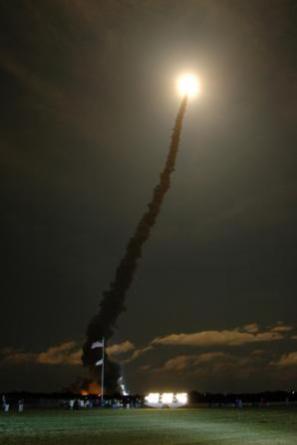Space Shuttle Discovery left launch complex pad 39B at 20:47h 35s local time (01:47h GMT on Sunday 10 December) in the first after sunset lift off for four years and is now on its way to begin the 12-day mission STS-116 to progress the construction of the International Space Station (ISS).
Speaking at the post-launch press conference at KSC NASA administrator Michael Griffin said: "[The launch] is the successful accomplishment of the most technically challenging thing that any nation can do. This is the best team in the world." Mission STS-116, also known as ISS assembly mission 12A.1, will see three extra-vehicular activities during which astronauts will install the P5 port truss segment, retract the P6 port solar array's wing and radiators and move power cables to enable the ISS to draw power from the arrays installed in September by Shuttle Atlantis' crew on STS-115.
|
|---|
Above: Space Shuttle Discovery ascends towards orbit |
The last after sunset launch was by Shuttle Endeavour on its mission STS-113 in November 2002. STS-116 is the 117th Shuttle mission, the 20th US construction mission to the ISS and Discovery's 33rd flight. As well as Fuglesang the STS-116 crew are NASA astronauts William Oefelein, pilot; Mark Polansky, commander; and Joan Higginbotham, Robert Curbeam, Sunita Williams, British born Nicholas Patrick, all mission specialists.
Curbeam, Fuglesang and Williams will conduct the space walks. Williams will not return with Discovery and instead join the ISS's current Expedition 14 and serve as a flight engineer aboard the station. Reiter, who arrived at the ISS in July onboard Discovery on mission STS-121 will return to Earth with the crew of STS-116 on 20 December.
The launch of Discovery/STS-116 will potentially be the last from pad 39B as it is to be used for the development of NASA’s proposed Ares I crew launch vehicle. Shuttles will in future be launched from pad 39A. However because of NASA’s ongoing policy of launching a rescue shuttle if an Orbiter discovered it was damaged after its ascent, pad 39B is required to ready a second Shuttle to back up the Hubble Space Telescope servicing mission - before pad 39A would be available.
The chance of weather stopping the launch of Discovery had been 30% with only 15kt (17.2km/h) crosswinds at KSC threatening lift off. Earlier in the day the Shuttle's abort landing sites in the US and Europe monitored by the US Air Force 45th weather squadron had a green status for the Trans-Atlantic Abort Landing (TAL) site in France and one of the two in Spain. Spanish TAL site Zaragoza has a red status and the two US abort sites at White Sands Missile Range in New Mexico and Edwards Air Force Base in California had issues regarding their cloud ceiling, which affects runway visibility for the Shuttle crew, but both locations were still green.
Earlier today NASA had to make a decision whether to start fuelling Discovery's external tank (ET) by 13:00h or abandon today's attempt after delays in the 48h turn around required after launch scrub on Thursday 7 December. As it takes around 3h to fuel the ET and because of the many elements required to occur before, during and after that operation to ready a Shuttle to launch, if fuelling had not begun by 13:00h the KSC team would have been unable to have the vehicle prepared for lift off by its launch window.
Weather conditions over KSC on Friday led NASA to opt for Saturday 9 December just an hour after scrubbing that launch of Discovery on Thursday 7 December. Saturday was predicted to have a 70% chance of weather prohibiting launch but during the afternoon and evening that fell to 30%.
Source: FlightGlobal.com
























